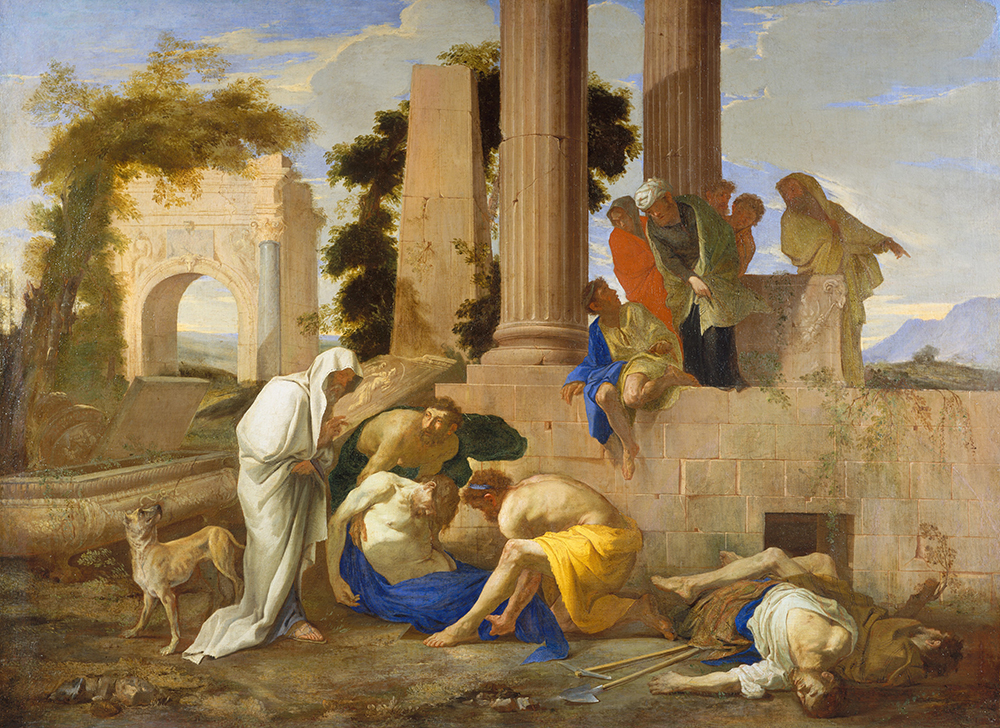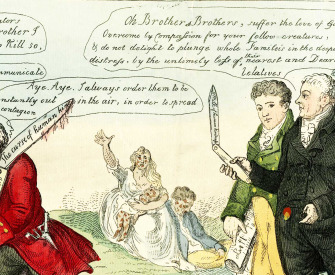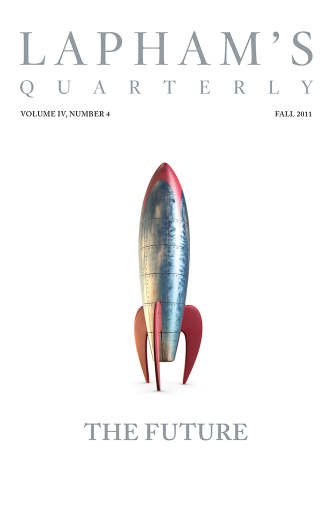In the month of December, symptoms of the plague manifested themselves at Nola; it was thought, and not without some foundation, that it was introduced there by contraband goods coming from Dalmatia or from the Levant, and left at the store of the Mastro Giocomo brothers.
The disease made rapid progress among the people, and general consternation was spread among the town. The physician sent by the governor of the province took the malady for a putrid exanthematous fever, but a new examination showed it to be the true plague; then the public authorities took the following severe measures:
The city was enclosed by two ditches six feet wide and the same in depth, the first sixty paces from the houses and the second thirty beyond. Twelve hundred troops acted as guards to prevent entrance and egress; sentinel posts were all in sight of each other, and the spaces were lit up at night with bonfires. There was but one entrance, this by a closed drawbridge. The death penalty was the fate of those who approached the ditches or attempted to escape; the same fate was held out to those who endeavored to traffic with the guards. A hospital destined for the reception of the sick was established in the town; it was provided with physicians, surgeons, nurses, servants, and gravediggers, all clothed in waxed cloth, with masks, gloves, and wooden shoes. They raised the covers from the patients and only touched their apparel and other effects with long iron-tipped sticks, to the end of avoiding all direct contact. All took care likewise to anoint their hands, arms, and feet with oil; they lived well, too, drinking good wines and bitter liquors; they were also careful to maintain free perspiration and keep their bowels open.
The nurses and servants gave the patients drinks and medicines with long iron forceps, and by the same method changed the soiled linen and emptied excrements; the soiled clothing was thrown into tubs strongly charged with acid; they were afterward cleansed with the greatest care. The hospital wards were neatly kept and all waste objects burned up every morning; fumigations were made with niter, and the floors were washed with antiseptic acids every night.
The gravediggers had long iron forceps and dropped the bodies on a stretcher having lengthy arms; then the remains were carried to a deep grave, where they were covered with lime and earth.
Another observation hospital was established, where all suspected cases were collected. It was only open to the physicians, who visited it several times each day, and it was rigorously guarded so as to avoid all contact with the rest of the town. When an individual in this hospital was found to be suffering from the plague, he was transferred as soon as possible to the pesthouse. The number of suspects increased, and the lazaretto grew overcrowded; it was divided into several sections. In the later months the disease declined. The persons who had so long been quarantined and had had no manifestations were washed, perfumed, given complete changes of clothing, and then transferred to another hospital, where they were considered as no longer suspected of contagion.
When one-quarter of the town was found affected, it was separated from the other quarters by balustrades. The people of easy circumstances who lived in different parts of the town from the poor were preserved from the plague and remained on the defensive. It was decided that the wealthy might remain in their own homes if they absolutely refrained from going out and permitted no one to enter their premises. Their food was to be distributed to them with all due sanitary precautions. All assemblages of persons were forbidden; the churches were closed, as well as the public eating houses and saloons; severe penalties were inflicted on those who disobeyed this latter order. All domestic animals were destroyed, seeing the properties that wool, fur, and hair have on retaining and transmitting contagious miasms. The town slaughterhouses were closed, and the only meat admitted was that with the hides off. All suspected objects were immediately burned, to avoid the spirit of rapine or a badly understood insight of danger as to the things considered unsafe. All citizens, under penalty of death, were obliged to make declarations of such articles. An individual taken in the violation of this act was judged by a drumhead court-martial and promptly executed on the public square.
The city was divided into eight sections, of which the six infected ones were enclosed by balustrades. Each section had its own sanitary committee, corresponding with a central committee; these committees were composed of good men—clergy, lawyers, businessmen, and doctors—and had at their disposal all the military forces, in order to give them a strong hand in enforcing all sanitary laws. Twice daily, at the sound of the clock, all persons in wealthy families were obliged to show themselves at their windows. Those who lived in humble quarters showed themselves at the entrances of their dwellings. Each committee thus visited its own section to ensure itself of the health of individual families, and if persons were noticed to be sick, such were transferred to hospitals as soon as possible. The remainder of families, in cases where sick were removed, were placed in observation hospitals, their houses closed, after all suspected articles capable of transmitting contagion had been destroyed. The committees were obliged to furnish such families with anything they wanted. Reports were prepared addressed to an outside sanitary commission, over the quarantine line. Such committees kept all streets and houses clean, too, and sought for suspected individuals and effects supposed to contain any contagion. Finally, the committees obliged a strict observation of established rules.
These measures were continued up to June 13, an epoch when no more plague patients were in the hospitals, and the disease seemed extinct. Before opening the town to the outside world again, the place was subjected to another triple quarantine.
The first was destined for a general visit of the inhabitants, in order to be assured that plague no longer existed. The second had for its object the general disinfection of dwellings and other places. It lasted forty days, and all furnishings were burned, as well as suspected household effects, in such places as the disease had been manifest. All metal objects were thoroughly washed with soap and water; doors, windows, walls, ceilings, and floors were then whitewashed with lime, after all crevices and holes had been sealed up with cement. All clothing was fumigated with flowers of sulfur. After all this the inhabitants were permitted to return home.
All church edifices were submitted to the same precautions, and those in which infected or suspected bodies had been interred were sealed up, and an inscription placed on a marble tablet gave the reasons for the closure of the sacred places. The streets were swept, as well as alleys and public places, and the dust burned or buried.
When all these measures had been finished, the sanitary inspectors declared, under oath, that disinfection was complete. A general bath was then ordered for the whole populace, after which they were obliged to use oil on all hairy parts of the body. Then 150 rounds were fired from the cannon, in order to procure concussion of the atmosphere; then the barriers were all removed.
The third quarantine commenced at this epoch and was not marked by injurious accidents; only some mild forms of intermittent fever were noticed. On November 1 the quarantine was raised, communication established with the outside world, and religious celebration occurred. The government, on its part, had executed the most rigorous measures to prevent all communication by land or sea upon the coast of the province of Bari. Sanitary cruising vessels prevented the entrance and departure of all boats, and all merchandise arriving by sea from all the parts of the realm was established two miles from Nola. All merchandise coming from Bari and Nola en route for Naples was stopped at the places where it was found. All goods capable of carrying contagion were destroyed as soon as captured. The crews were submitted to quarantine before being permitted to depart again. All the cotton going from Nola to Naples was housed up to the month of December, and wire seals marked all that held in storehouses, which was purified. All letters were plunged into strong vinegar and then fumigated. No person from Bari could travel without a health certificate, and all things capable of holding contagion had to be reported to the public authorities and were cleansed. It was the death penalty for anyone to introduce anything from Nola without official notification. Finally, thanks to such rigorous measures, the disease was limited to the single town of Nola and was extinguished there.
From Medical History, General and Particular, of Epidemic Diseases. “Pestilential miasms have principles as little known to us as those of electricity, but the effects are just as prompt and active as lightning,” writes Ozanam, a medical scholar and practitioner, in this five-volume history, published from 1817 to 1823. During the outbreak in Nola, in the Kingdom of Naples, only a thousand people were infected, of whom 728 died, leading the English translator of Ozanam’s account, in 1897, to interject: “It is doubtful whether moderns could do as well.”
Back to Issue


